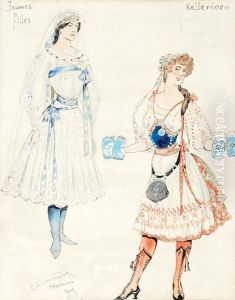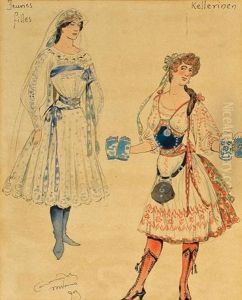Luigi Sapelli Paintings
Luigi Sapelli, known by his pseudonym Caramba, was an Italian painter, illustrator, and cartoonist born on April 30, 1865, in Turin, Italy. He is recognized for his contributions to the world of Italian caricature and illustration during the late 19th and early 20th centuries. Sapelli's work was characterized by a distinct style that often incorporated humor and satirical elements, reflecting the socio-political environment of his time.
Caramba studied at the Albertina Academy of Fine Arts in Turin, where he honed his artistic skills. After completing his education, he began working as an illustrator and cartoonist for various Italian newspapers and periodicals, including 'L'Asino,' 'Il Fischietto,' and 'La Rana.' His satirical drawings quickly gained popularity for their wit and incisive social commentary.
Throughout his career, Sapelli also engaged in painting, producing works that were exhibited in several galleries and shows. However, his lasting legacy remains in the field of illustration, where he contributed significantly to the visual culture of the era. His caricatures often depicted politicians, celebrities, and everyday people, capturing the spirit of the Belle Époque and the interwar period with a sharp and often humorous eye.
Luigi Sapelli's influence extended beyond his illustrations. He was also involved in teaching, sharing his expertise with younger generations of artists. His dedication to his craft and his ability to capture the essence of his subjects with both empathy and critical distance made him a respected figure in Italian art circles.
Caramba continued to work until his later years, maintaining his relevance as a commentator on Italian life through his art. He passed away on July 31, 1936, in his hometown of Turin, leaving behind a rich legacy of work that continues to be studied and admired for its artistic and historical significance. His contributions to the field of caricature and illustration remain an important part of Italy's cultural heritage, offering insights into the country's past and the universal language of satire.

